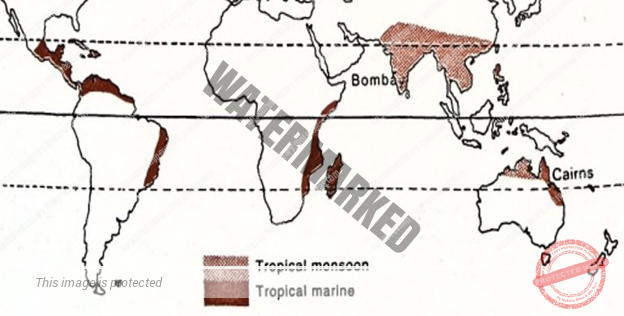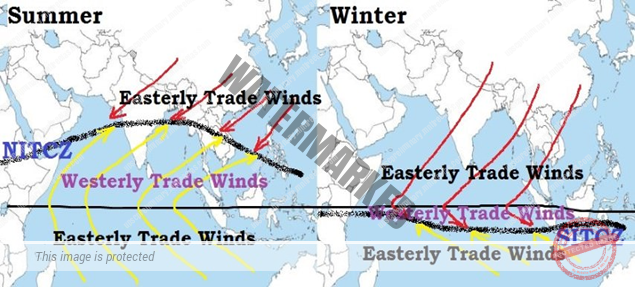- FACTORS AFFECTING THE DEVELOPMENT OF EQUATORIAL REGIONS
- DISTRUBUTION OF TROPICAL MONSOON CLIMATE
UNIT 4 – CLIMATOLOGY – PART 30
FACTORS AFFECTING THE DEVELOPMENT OF
EQUATORIAL REGIONS
Equatorial climate and health
Excessive heat (sunstroke) and high humidity creates serious physical and mental handicaps.
High humidity feeds many tropical diseases such as malaria and yellow fever.
Communicable diseases are rampant as germs and bacteria are transmitted through moist air.
Insects and pests not only spread diseases but are injurious to crops.
Jungle hinders development
The construction of roads and railways is a risky business as workers are exposed to wild animals, poisonous snakes, insects and most importantly tropical diseases.
Once completed, they have to be maintained at a high cost.
Rapid deterioration of tropical soil
Why does restoration of lost forests take decades in equatorial regions?
The fertility of topsoil in rainforest regions is very poor. Torrential downpours wash out most of the topsoil nutrients [leaching == percolation and draining way of nutrients due to rainwater action].
The soil deteriorates rapidly with subsequent soil erosion and soil impoverishment.
It takes decades to replenish the soil of lost nutrients.
So, a seed doesn’t usually germinate and even if it does, its development is hindered due to little availability of sunlight.
Lalang (tall grass) and thick undergrowth spring up as soon as the trees are cut. They choke the restoration of forests.
Indonesian island of Java is an exception because of its rich volcanic ashes.
Difficulties in livestock farming
Livestock farming is greatly handicapped by an absence of meadow grass. The grass is so tall and coarse that it is not nutritious.
The few animals like buffaloes are kept mainly for domestic use. Their yield in milk or beef is well below those of the cattle in the temperate grasslands.
In Africa, domesticated animals are attacked by tsetse flies that cause ngana, a deadly disease.
MINERAL RESOURCES
Gold, Copper, Diamonds, and other precious metals and gemstones are important resources that are found in rainforests around the world.
Extracting these natural resources is a destructive activity that damages the rainforest ecosystem.
Examples are gold mining in the Brazilian and Peruvian Amazon, rare earth mining in the Congo, and gold and copper mining in Indonesia and Papua New Guinea.
Some of the world’s most promising oil and gas deposits lie deep in tropical rainforests.).
More than 70 percent of the Peruvian Amazon is now under concession for oil and gas.
The Tropical Monsoon & Tropical Marine Climates (Am)
DISTRIBUTION OF TROPICAL MONSOON CLIMATE
- Occur within 5° to 30°N and S of the equator.
- On-shore [sea to land] tropical monsoons occur in the summer and off-shore [land to sea] dry monsoons in the winter.
- They are best developed in the Indian sub-continent, Burma, Thailand, Laos, Cambodia, parts of Vietnam and south China and northern Australia.
- The basic cause of monsoon climates is the difference in the rate of heatingand cooling of land and sea (This is old theory.
- In the summer, when the sun is overhead at the Tropic of Cancer, a low pressure is created in Central Asia.
- The seas, which warm up much slower, remain comparatively at high pressure. At the same time, the southern hemisphere experiences winter, and a region of high pressure is set up in the continental interior of Australia.
- Winds blow outwards as the South-East Monsoon, to Java, and after crossing the equator are drawn towards the continental low-pressure area reaching the Indian sub-continent as the South-West Monsoon (Coriolis force).
- In the winter, conditions are reversed.
TEMPERATURE
- Monthly mean temperatures above 18 °C.
- Temperatures range from 30-45° C in summer. Mean summer temperature is about 30°C.
- In winters, temperature range is 15-30° C with mean temperature around 20-25° C.
PRECIPITATION
- Annual mean rainfall ranges from 200-250 cm. In some regions it is around 350 cm.
- Places like Cherrapunji & Mawsynramreceive an annual rainfall of about 1000 cm. [They lie on the windward side of the Meghalaya hills, so the resulting orographic lift (orographic rainfall) enhances precipitation. Also, they are located between mountains which enhances cloud concentration due to funneling effect]
SEASONS
- Seasons are chief characteristics of monsoon climate.
THE COOL, DRY SEASON (OCTOBER TO FEBRUARY)
- Out blowing dry winds, the North-East Monsoon, bring little or no rain to the Indian sub-continent.
- However, a small amount of rain falls in Punjab from cyclonic sources (Western Disturbances: Frontal precipitation brought by jet streams) and this is vital for the survival of winter cereals.
- North-East Monsoons blowing over the Bay of Bengal acquires moisture and bring rains to the south-eastern tip of the peninsula at this time of the year (Nov-Dec).
THE HOT DRY SEASON (MARCH TO MID-JUNE)
- The temperature rises sharply with the sun’s northward shift to the Tropic of Cancer.
- Day temperatures of 35° C are usual in central India and the mean temperature in Sind and south India may be as high as 44° C.
- Coastal districts are a little relieved by sea breezes. There is practically little rain. [Hailstorms (thunderstorms with hail) occurs here and there]
The rainy season (mid-June to September)
- With the ‘burst’ of the South-West Monsoon in mid-June, torrential downpours sweep across the country. Almost all the rain for the year falls within this rainy season.
- This pattern of concentrated heavy rainfallin summer is a characteristic feature of the Tropical Monsoon Climate.


